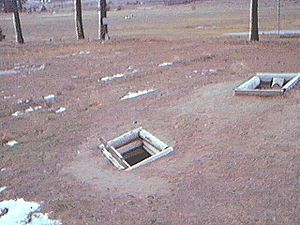Quiggly hole facts for kids
A quiggly hole (also called a pit-house or kekuli) is what's left of an old underground home. These homes were built by First Nations people. They lived in places like the Interior of British Columbia in Canada and the Columbia Plateau in the United States. The word quiggly comes from an old trade language called Chinook Jargon. It means "beneath" or "under."
Contents
What Quiggly Holes Look Like
A quiggly hole looks like a round dip in the ground. It's what's left after a log-roofed pit-house has fallen apart. These homes were sometimes called a barabara or an ulax.
Quiggly Towns
Quiggly holes often appear in big groups. These groups are known as quiggly towns. Some towns have hundreds of holes. This suggests that thousands of people might have lived there. Some holes were for families to live in. Others might have been used just for storage.
Quiggly towns were usually built in good spots. These spots had lots of sunlight and a good water supply. They also had easy access to fish, game, and wild plants for food.
Where to Find Them
You can find quiggly towns in southern British Columbia. They are common in the Fraser Canyon near Lillooet. You can also see them along the Thompson River valley and down the Okanagan Valley.
The old site of Fort Chilcotin at Hudson's Bay Flats has several quiggly holes. The Thompson River between Pritchard and Kamloops also has them. People have found old tools like arrowheads and scrapers in quiggly holes. Some people who look for rocks and artifacts believe that digging around these holes can harm history. It can destroy important clues about the past.
Famous Quiggly Sites
One very famous quiggly town is the Keatley Creek Archaeological Site. It is in the Fraser Canyon. This site is between the modern First Nations communities of Fountain and Pavilion. It has over 115 quiggly holes.
Scientists have studied this site carefully. They found that it was first used between 4,800 BCE and 2,400 BCE. People continued to live there until about 1,100 BCE. Scientists think the site was left empty because a landslide blocked the Fraser River. This created a large lake. Keatley Creek would have been near the lake's shore. Today, it sits high above the river's canyon.
How Quiggly Homes Were Built
These underground structures were used for living, cooking, and storage. They might have started as a bigger version of a root cellar. The most complex ones had a deep pit covered by a log frame. Then, earth was piled over the frame to make a dome.
People usually entered these homes in one of two ways. They might use a side entrance. Or, they might use a ladder through a smoke hole in the roof. Today, the word quiggly usually means the old remains. It doesn't mean a working underground house.
Similar Structures Today
Similar structures are used for sweat lodges in First Nations communities today. However, sweat lodges are made with sticks, branches, and blankets. They are not built with logs and earth. Like sweat lodges, some quiggly holes were likely used for special ceremonies and community gatherings.
When Quiggly Homes Were Used
Quiggly homes were the main type of housing for Interior cultures before Europeans arrived. They were used for either seasonal or permanent settlements. People on the southern British Columbia Coast and Puget Sound used them less. There, log-frame longhouses were more common.
People in the Interior started moving into modern-style homes in the late 1800s. But some people still lived in active underground houses until the mid-1900s. In the 1800s, missionaries tried to get Indigenous people to live in log-cabin villages.
Rebuilding a Quiggly Home
You can see a rebuilt underground house near the Lillooet Tribal Council's offices. This is in the community of Tʼtʼikt (also called the "T-bird Rancherie") in Lillooet, British Columbia.
This type of home is called a si7xten (pronounced SHIH-stn) in the St̓át̓imcets language. Its design is based on notes from an anthropologist named James Teit. He had lived with the Nlakaʼpamux people in Spences Bridge. Teit had never been to Lillooet. He learned about the si7xten from interviews with a Stʼatʼimc woman. She had married into the Spences Bridge people.
Teit's drawings also used his knowledge of underground houses in other valleys. In his time, people still lived in these homes. The rebuilt si7xten in Lillooet was made using his designs. However, it might not look exactly like the ones the Stʼatʼimc people used. This is because the people who knew how to build them had passed away before there was interest in rebuilding one.
Quiggly towns are very important for First Nations land claims. They are more than just symbols of where people lived. They are proof of ownership and rights to the land. Keeping track of quiggly holes and other old sites is a key part of land claims. Laws like the British Columbia Heritage Conservation Act protect them. This act protects quigglies on both public and private land.
Many quiggly towns are quite old, some hundreds of years. Others, like Keatley Creek, are very ancient. Besides the Plateau cultures, some quiggly-like structures have been found on the Oregon Coast. This area usually had log-frame houses. Scientists believe the people who lived there were ancestors of the Athapaskan people. They likely used their familiar housing style when they first moved to the region.




